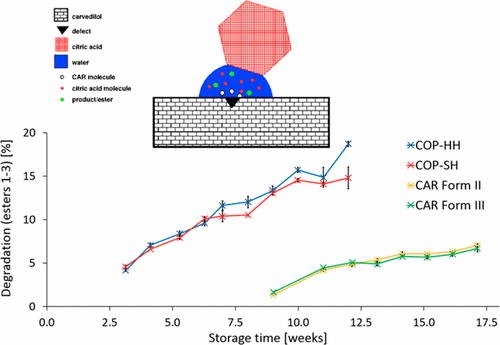当前位置:
X-MOL 学术
›
Mol. Pharmaceutics
›
论文详情
Our official English website, www.x-mol.net, welcomes your
feedback! (Note: you will need to create a separate account there.)
Drug–Excipient Interactions in the Solid State: The Role of Different Stress Factors
Molecular Pharmaceutics ( IF 4.5 ) Pub Date : 2017-11-02 00:00:00 , DOI: 10.1021/acs.molpharmaceut.7b00677 Corinna Gressl 1 , Michael Brunsteiner 1 , Adrian Davis 2 , Margaret Landis 3 , Klimentina Pencheva 2 , Garry Scrivens 2 , Gregory W. Sluggett 3 , Geoffrey P. F. Wood 3 , Heidrun Gruber-Woelfler 1, 4 , Johannes G. Khinast 1, 4 , Amrit Paudel 1
Molecular Pharmaceutics ( IF 4.5 ) Pub Date : 2017-11-02 00:00:00 , DOI: 10.1021/acs.molpharmaceut.7b00677 Corinna Gressl 1 , Michael Brunsteiner 1 , Adrian Davis 2 , Margaret Landis 3 , Klimentina Pencheva 2 , Garry Scrivens 2 , Gregory W. Sluggett 3 , Geoffrey P. F. Wood 3 , Heidrun Gruber-Woelfler 1, 4 , Johannes G. Khinast 1, 4 , Amrit Paudel 1
Affiliation

|
Understanding properties and mechanisms that govern drug degradation in the solid state is of high importance to ensure drug stability and safety of solid dosage forms. In this study, we attempt to understand drug−excipient interactions in the solid state using both theoretical and experimental approaches. The model active pharmaceutical ingredients (APIs) under study are carvedilol (CAR) and codeine phosphate (COP), which are known to undergo esterification with citric acid (CA) in the solid state. Starting from the crystal structures of two different polymorphs of each compound, we calculated the exposure and accessibility of reactive hydroxyl groups for a number of relevant crystal surfaces, as well as descriptors that could be associated with surface stabilities using molecular simulations. Accelerated degradation experiments at elevated temperature and controlled humidity were conducted to assess the propensity of different solid forms of the model APIs to undergo chemical reactions with anhydrous CA or CA monohydrate. In addition, for CAR, we studied the solid state degradation at varying humidity levels and also under mechano-activation. Regarding the relative degradation propensities, we found that variations in the exposure and accessibility of molecules on the crystal surface play a minor role compared to the impact of molecular mobility due to different levels of moisture. We further studied drug−excipient interactions under mechano-activation (comilling of API and CA) and found that the reaction proceeded even faster than in physical powder mixtures kept at accelerated storage conditions.
中文翻译:

固态中的药物-赋形剂相互作用:不同应激因素的作用
理解控制固态药物降解的特性和机理对于确保药物稳定性和固体剂型的安全性至关重要。在这项研究中,我们尝试使用理论和实验方法来理解固态中的药物-赋形剂相互作用。研究中的模型活性药物成分(API)是卡维地洛(CAR)和磷酸可待因(COP),已知它们会以固态与柠檬酸(CA)进行酯化反应。从每种化合物的两种不同多晶型物的晶体结构开始,我们使用分子模拟计算了许多相关晶体表面的反应性羟基的暴露度和可及性,以及可能与表面稳定性相关的描述符。在升高的温度和受控的湿度下进行了加速降解实验,以评估模型API的不同固体形式与无水CA或CA一水合物进行化学反应的倾向。此外,对于CAR,我们研究了在不同湿度水平以及机械活化下的固态降解。关于相对降解的倾向,我们发现,由于水分含量不同,与分子迁移率的影响相比,晶体表面上分子的暴露和可及性的变化起着较小的作用。我们进一步研究了机械活化(API和CA混合)下的药物-赋形剂相互作用,发现该反应的进行速度甚至比在加速储存条件下的物理粉末混合物还要快。
更新日期:2017-11-03
中文翻译:

固态中的药物-赋形剂相互作用:不同应激因素的作用
理解控制固态药物降解的特性和机理对于确保药物稳定性和固体剂型的安全性至关重要。在这项研究中,我们尝试使用理论和实验方法来理解固态中的药物-赋形剂相互作用。研究中的模型活性药物成分(API)是卡维地洛(CAR)和磷酸可待因(COP),已知它们会以固态与柠檬酸(CA)进行酯化反应。从每种化合物的两种不同多晶型物的晶体结构开始,我们使用分子模拟计算了许多相关晶体表面的反应性羟基的暴露度和可及性,以及可能与表面稳定性相关的描述符。在升高的温度和受控的湿度下进行了加速降解实验,以评估模型API的不同固体形式与无水CA或CA一水合物进行化学反应的倾向。此外,对于CAR,我们研究了在不同湿度水平以及机械活化下的固态降解。关于相对降解的倾向,我们发现,由于水分含量不同,与分子迁移率的影响相比,晶体表面上分子的暴露和可及性的变化起着较小的作用。我们进一步研究了机械活化(API和CA混合)下的药物-赋形剂相互作用,发现该反应的进行速度甚至比在加速储存条件下的物理粉末混合物还要快。











































 京公网安备 11010802027423号
京公网安备 11010802027423号